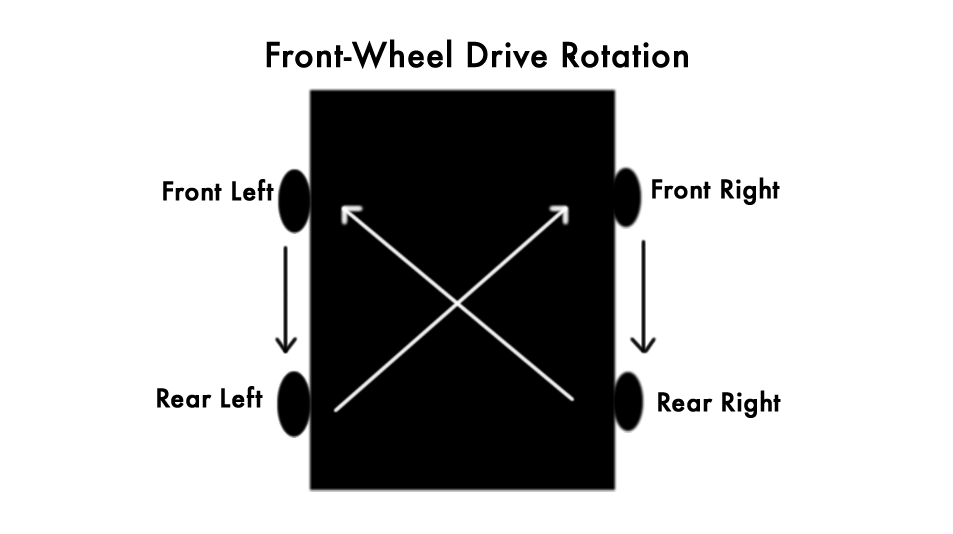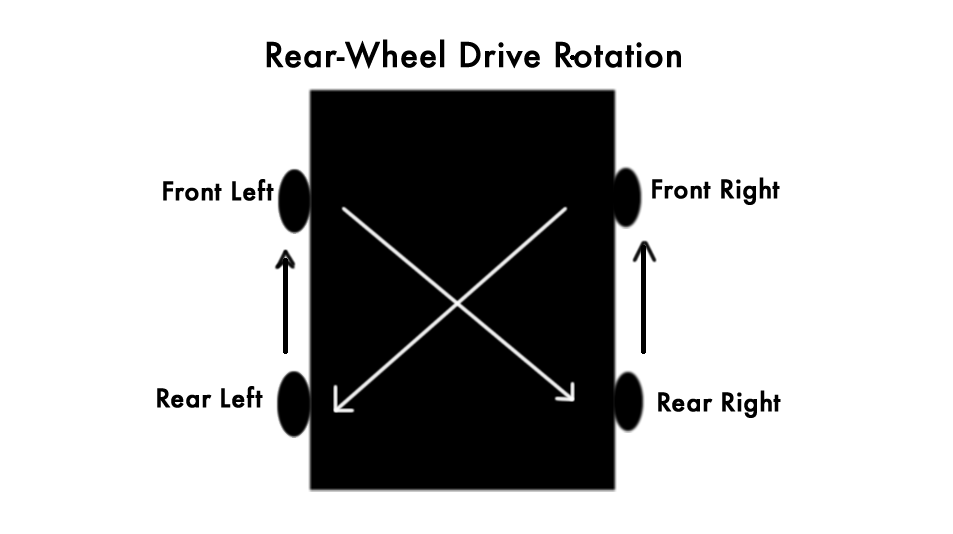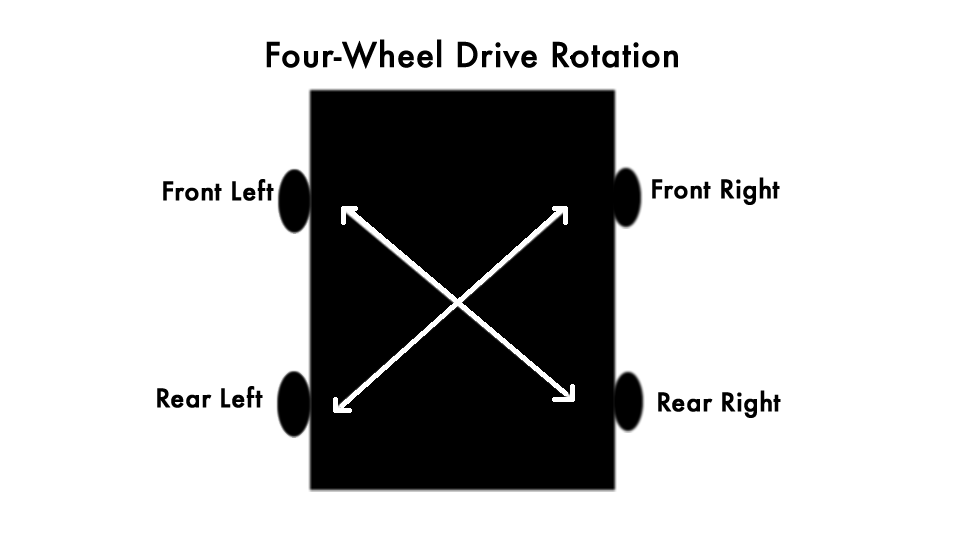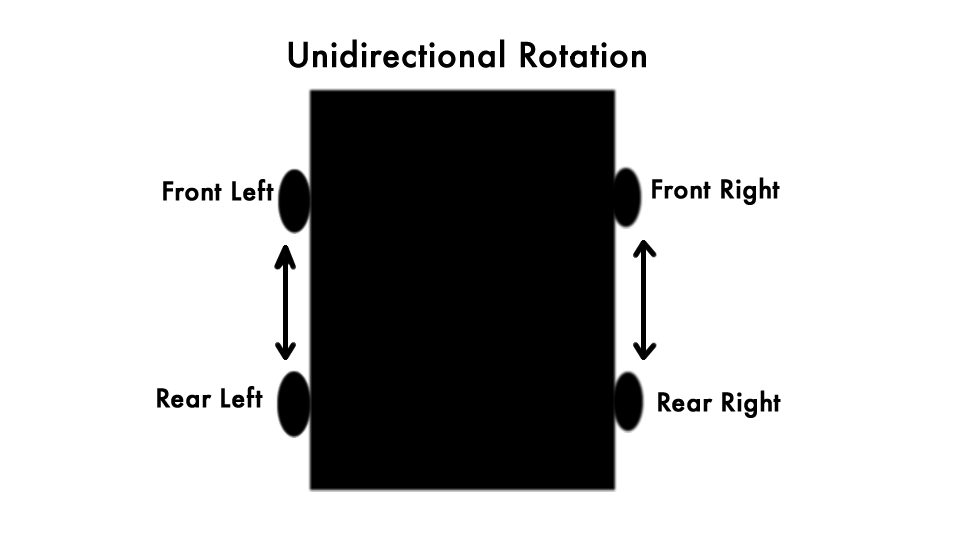Rotating your tires just means moving them from one position to another. This can be done in a variety of patterns, depending on what your particular car needs. Tires can move from front to back, back to front, right to left, up, down, and all around. Don’t let all this info tire you out, though! Keep reading and we’ll break it down for you.
Why should I move my tires around?
“After all, aren’t my tires being ‘rotated’ every time I drive my car?” An astute observation, but here’s the scoop: your tires do not wear evenly while driving. If your car engine is located in the front, then you’re going to have more weight in the front, and the same principle applies if your engine is located in the back. This uneven distribution of weight is one reason for uneven tire wear. Furthermore, certain driving habits – such as making sharper right turns than left turns – will affect your tires.
Failing to rotate your tires won’t cause any direct mechanical damage to your car (such as engine damage due to dirty oil). However, it’s still an important aspect of car maintenance. For one, tires aren’t that cheap; you might be looking at around $400 for a new set of tires. So, if you like the idea of saving some cash when it comes to car care, then it might be in your best interest to keep those tires of yours lasting for as long as you can. Rotating your tires will do just that by making sure they’re being worn evenly.
If you have uneven tire wear, then you might also notice that the car becomes a bit tougher to handle. Being able to drive and handle your car safely should always be top priority, so you want to make sure every aspect of your car – including your tires – are in great condition.
Ok, that makes sense. But how do I know which tire goes where?
First, you need to know if your tires are directional or non-directional. If you take a look at your tires, you may notice that they have an arrow on the sidewall. These are directional tires, and their purpose is to help with wet traction. When rotating these, just remember that they can only move from front to back, not side to side. You may also have tires that say “OUTSIDE” on them, or something similar. This means that the side that says “OUTSIDE” should always be facing outside rather than inwards.
If you read all that and started panicking because your tires don’t have arrows or words on them, fret not! This just means that your tires are non-directional.
There are four main tire rotation patterns for non-directional wheels: front-wheel drive, rear-wheel drive, 4-wheel drive, and uni-directional.
 If your car is a front-wheel drive – like one version of the 2015 Ford Edge – then you’ll want to move your front tires to the rear, and your rear tires will move to the front diagonally. In other words, your rear left tire will move to the front right, and your rear right tire will move to the front left.
If your car is a front-wheel drive – like one version of the 2015 Ford Edge – then you’ll want to move your front tires to the rear, and your rear tires will move to the front diagonally. In other words, your rear left tire will move to the front right, and your rear right tire will move to the front left.
- For rear-wheel drive cars, like the 2016 Mazda MX-5 Miata, your back tires will move to the front, and your front tires will move to the back diagonally. The front right tire will move to the rear left, and the front left tire will move to the rear right.
- On cars with 4-wheel drive (example: the 2015 GMC Yukon K1500), both front and back tires will switch diagonally. Front left with rear right, and front right with rear left.
- Unidirectional is pretty simple; just move the front to the back and vice versa. No need to worry about any crazy diagonal movements for this one.
How often should I rotate my tires?
Like your oil change, your owner’s manual will let you know how often you should rotate your tires. Also like your oil change, it’s recommended that you do this around every 5,000 miles or so. If you take your vehicle into a shop to change the oil, it’s likely that they can perform a complimentary tire rotation.
To round off this post, it’s worth mentioning that shops and mechanics can check your wheel alignment if you go in for a service like changing your oil or a tire rotation. Tires and wheels go hand in hand, like peanut butter and jelly. So while you run out and take care of those tires, know that you can always turn to us for all of your rim needs.
Hoping you never tire of my puns,
– Kathy
OriginalWheels.com



